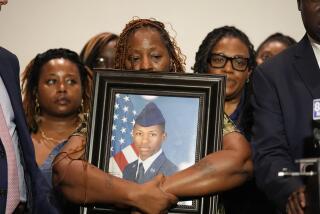Questions Linger a Year After Deputy Killed His Colleague : Investigation: Some on county grand jury that heard related testimony are joining in criticism of the case.
- Share via
SANTA ANA — One year after a deputy sheriff shot and killed a fellow deputy during an impromptu training session on Christmas Day, 1993, questions raised by the shooting incident have not waned, and in some instances have only grown more troubling.
Although a full year has passed, the deputy who fired the fatal shot has not returned to work, and a decision on any disciplinary action he might face is still pending.
Deputy Brian P. Scanlan was placed on paid leave after shooting Deputy Darryn Leroy Robins in the face on Dec. 25, 1993, behind a Lake Forest theater, where Robins--apparently trying to demonstrate how bad guys can get the drop on officers--pulled a concealed weapon and pointed it at Scanlan during a mock traffic stop.
Startled, Scanlan “jerked back,” and fired a single shot into the 30-year-old deputy’s face, according to a subsequently released statement Scanlan made to investigators.
The killing triggered a lengthy controversy that was not put to rest even by a county grand jury ruling in the matter, not the least because Scanlan is white and Robins was black.
At one point, minority leaders tried unsuccessfully to get state or federal authorities to take over the formal investigation into the slaying, voicing concerns that the investigation by the Orange County district attorney’s office might be tainted by its need to preserve good working relations with the Sheriff’s Department.
The district attorney’s office concluded that Scanlan had been “grossly negligent” and says it wanted Scanlan charged with involuntary manslaughter. But county prosecutors left the final decision in the hands of the Orange County Grand Jury that was sitting at the time.
That grand jury--which was then under fire for not having enough minority panel members--declined to issue an indictment, and that decision effectively sealed for all time the transcripts of what transpired behind closed doors in the grand jury proceedings.
For minority leaders who raised questions about the pace and thoroughness of the investigation, the secrecy enshrouding the case has only left wounds to fester.
“Deputy Scanlan will forever have this hanging over his head, (and) we will forever have questions about what really happened that day. Nothing has really been solved in that way,” said Eugene Wheeler, president of 100 Black Men of Orange County, a group that found itself leading efforts to get answers about the tragedy.
Although suggestions that race influenced the handling of the case were disputed by law enforcement, investigative records, and even Robins’ widow, it nonetheless remains a sore point for Wheeler and others.
And for the first time, grand jurors who listened to testimony in the case are joining some of the critics--although they do not agree that race played a role in the killing or the subsequent investigation.
*
Anaheim retiree John Jeffers Baird, one of the panel’s members, said he remains “surprised” by the grand jury’s decision not to indict. But he refused to say how he voted on the case, noting that grand jurors who reveal details of the secret proceedings can be charged with a misdemeanor.
“All I can say is it was a very painful episode, and I can assure you I will never forget it,” Baird said. “I can say I was very surprised at the way it turned out, after the information we were given.”
But another grand juror who spoke on the condition that his identity not be revealed went further.
“They (prosecutors) didn’t have to do the dirty work, because we did it for them,” said the juror. “The DA decided to come to us because they knew what the outcome would be when you bring a case like this before a bunch of older retirees, with only a few minorities” among the jurors.
“If anyone deserved to be indicted, he deserved to be indicted,” the juror said. “I’m not saying he deserves to spend the rest of his life in jail. But this was grossly, grossly negligent. I will be troubled by this until the day I die. I can’t think of Christmas without thinking of this.”
But prosecutor Guy Ormes, who oversees special assignments at the Orange County district attorney’s office, strongly disagreed with the criticism.
“We went down there asking for an indictment. No one disagrees with that, so I don’t think anyone can say otherwise,” Ormes said. Noting that the case was an emotional one, Ormes said a public consensus would never be reached.
“I know there were people who criticized the grand jury and our office. . . . But had the grand jury voted for an indictment, people would have been upset about that,” Ormes said. “No one has ever been happy about this case.”
The grand jurors who spoke about the case agreed that prosecutors presented it in a professional and unbiased manner. But missing from the information presented to them in March, 1994, were the results of a coroner’s review, which was not completed until later that spring.
The review included a re-enactment of the incident, and lifelike dummies and sheriff’s vehicles were used to re-create the event. As a result of the review, the coroner’s office concluded that the cause of Robin’s death was homicide--as opposed to an accidental death--as reflected on the June 15, 1994, death certificate.
“I think that re-enactment, that review, could have made a difference, but maybe not,” the juror said.
Some things have changed since the shooting.
The Orange County Sheriff’s Department policy now restricts all training with loaded weapons to the sheriff’s academy, and bars the use of any firearm in field training sessions. Even a clearly marked toy--such as a red plastic gun--is now off limits.
“You can use your finger (to simulate a gun during training) but that’s it,” said Sheriff’s Department spokesman Lt. Tom Garner.
*
Many deputies say Robins’ killing has given them a heightened sense of safety, making the slain deputy a positive force even after his death. “I know they reflect on this a lot, it’s been a difficult year,” said Robert MacLeod, general manager of the Assn. of Orange County Sheriff’s Deputies.
The case remains under review by the U.S. Department of Justice, which has been looking to determine whether federal civil rights charges might be warranted against Scanlan.
Robins’ widow and his mother have not filed suit against the county, although they have filed claims--often a precursor to a lawsuit. The county did not reject the claims in writing, but has allowed the 45-day response period to expire, opening the way to possible court action.
A comparison of the two claims also illustrates the divisions people feel about the case.
Rosemary Robins, the widow, has indicated she will seek $15 million from the county, claiming that the department knew officers routinely trained with loaded weapons in the field.
Mildred Fisher, his mother, alleges that Scanlan violated her son’s civil rights and that Scanlan had a history of reckless conduct and racial discrimination--allegations that have been denied.
Efforts to reach Scanlan and his attorney were not successful, and Robins’ survivors have declined to comment.
“It’s Christmas. This is all a reminder to them,” said Anne Yeager Higgins, who is representing Fisher.
More to Read
Sign up for Essential California
The most important California stories and recommendations in your inbox every morning.
You may occasionally receive promotional content from the Los Angeles Times.











